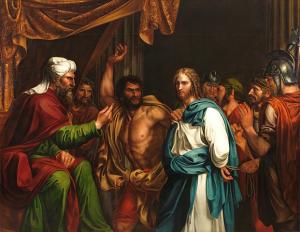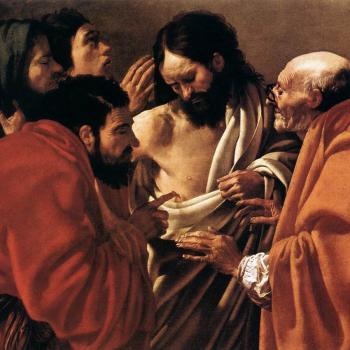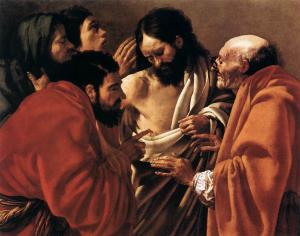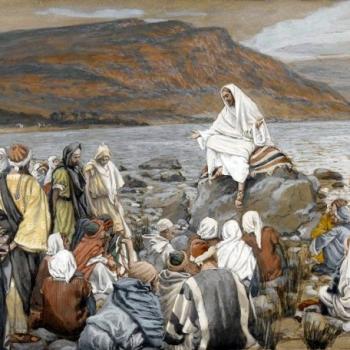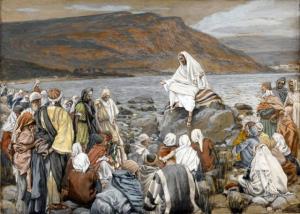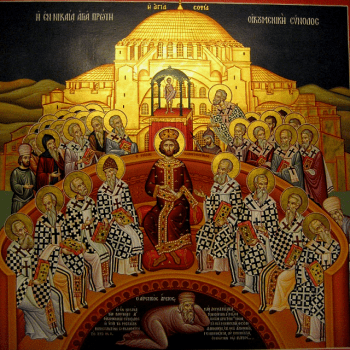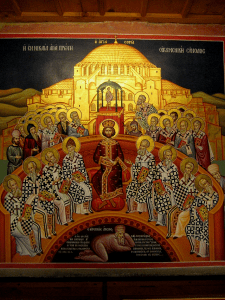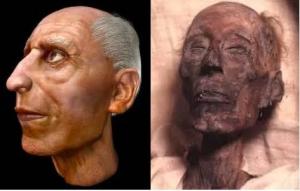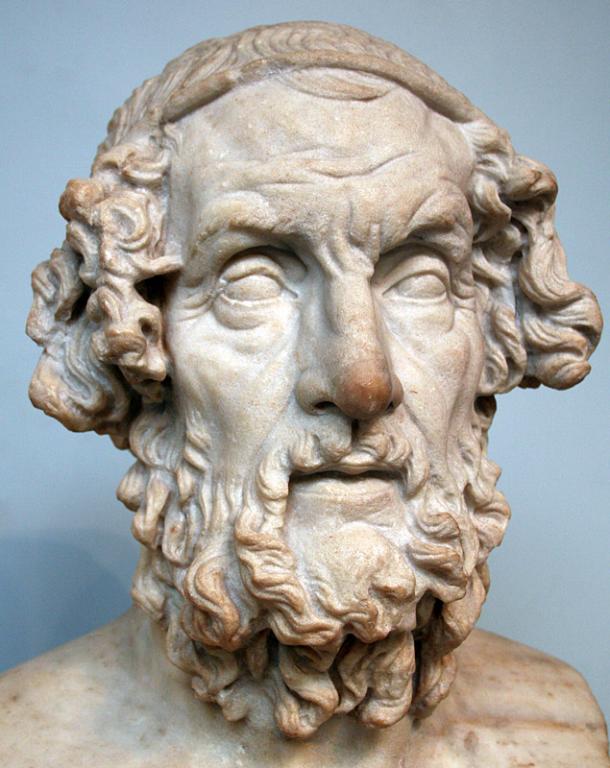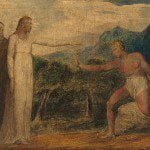
Atheist anti-theist Jonathan M. S. Pearce is the main writer on the blog, A Tippling Philosopher. His “About” page states: “Pearce is a philosopher, author, blogger, public speaker and teacher from Hampshire in the UK. He specialises in philosophy of religion, but likes to turn his hand to science, psychology, politics and anything involved in investigating reality.” His words will be in blue.
*****
Jonathan managed to scrounge up a desperate pseudo-pseudo-quasi-“reply” [choke] to my most recent paper on Noah’s Flood with passing references to my earlier primary one: Local Mesopotamian Flood: An Apologia. He completely ignored another preliminary paper (Local Flood & Atheist Ignorance of Christian Thought), that dealt with biblical language, and why virtually all Christians scholars believe in a local, not a universal Flood.
It’s a case study of intellectual evasion and cowardice and relentless unwillingness to engage point-by-point, with the usual mockery and condescension that we have come to know and love from almost all atheists (at least of the anti-theist variety) who interact online with Christians at all. He calls his “reply” God, Floods, Miracles and Evidence (10-1-21).
It’s an argument about physical evidence, and, of course, there is no physical evidence for it – whether global or regional.
It’s also an argument from analogy, dealing with the science of what is possible and what could have been entailed in Noah’s Flood. Part of Jonathan’s argument is that even a local Flood, such as what I proposed, is not possible according to the laws of science and specifically of the behavior and characteristics of water, storm systems, etc. Therefore, if I show that it is indeed possible, his counter-argument is defeated. In that respect, it is not simply about literal physical evidence. But there actually is some of that (that Jonathan ignored or never read: per his usual sloppy and unsystematic modus operandi.
The scientific article that I mostly relied on, from geologist Carol A. Hill, was “Qualitative Hydrology of Noah’s Flood”, Perspectives on Science and Christian Faith (Volume 58, Number 2, June 2006). She maintained:
At Shuruppak, and also at Uruk, the last Jemdet Nasr remains are separated from the subsequent Early Dynastic I Period by clean, water-lain clay deposited by a flood. This clay is nearly five feet thick at Uruk [60] and two feet thick at Shuruppak. [61] Since the Sumerian King List mentions that Noah (Ziusudra) lived in Shuruppak (today the archaeological mound of Fara), and since Noah is believed to have lived during the Jemdet Nasr Period, [62] then these sediments date from the right time and place and may be deposits left by Noah’s Flood. [c. 2900 BC]
A popular misconception is that a great inundation such as Noah’s Flood should have left a widespread layer of sediment all over Mesopotamia. If flood deposits occur at Shuruppak (Fara), then why not at nearby Kish? Why have no flood deposits been found at Ur that correspond to Noah’s Flood, and why in the city-mound of Ur do some pits contain thick flood deposits while other pits nearby contain no flood deposits?
This presumed problematic situation is completely understandable to hydrologists—in fact, it is what they expect. Floods erode sediment as well as deposit sediment. Rivers in vegetated terrain (like in northern Mesopotamia) are capable of eroding less sediment than in unvegetated, clay-silt terrain (like in southern Mesopotamia). Rivers may scour and down cut sediment along steep gradients, whereas they may deposit sediment in shallow-gradient situations. Or, sediment left from the waters of one flood may be removed by erosion in a later flood. Most Mesopotamian cities were located close to former river channels or canals since commerce and transportation depended on these waterways.
Apologist Dave Armstrong was complaining that I wasn’t interacting with his apologia for a localised flood. So I half-read it. I say half because I got halfway down and couldn’t take any more. I declared, “I literally don’t understand how someone can rationally assent to the claim.”
There you have it folks. He not only refused to grapple with my paper (or it’s preliminary / introductory precursor) point-by-point, he also didn’t even read the whole thing. By his own estimate he only read “half” of it. This is not the response of one who is confident of his own positions, or who has a robust courage of his convictions. It’s sophistry and special pleading, obscurantism and obfuscation.
His first piece (linked above) essentially boils down to “God did a miracle” (we’ll get onto this in a bit) as well as, “but just in case he didn’t, here’s a bunch of modeling and ‘evidence’ to suggest it could well be natural”. He’s eating his cake and keeping it, too.
This is a gross caricature of my thought (what else is new with Jonathan?). Christian thinking with regard to the relationship of God, natural laws, and miracles is far more sophisticated than Jonathan thinks. I wrote:
Sometimes in the Bible God is described as having caused something that is actually natural. In these cases, the meaning would be that God “upholds” creation and/or caused the origin of natural laws in the first place, which now govern natural events, short of the rare miraculous divine intervention with a miracle. Other times it is purely miraculous . . .
Then I cited Carol Hill:
One does not have to invoke the notion of the suspension or violation of natural laws in “nature miracles.” Divine action can simply be understood as higher-order laws (God’s ultimate purpose) working seamlessly with lower order laws (God’s physical laws). Is it any less a miracle because it can be explained by natural processes? This is the nature of “nature miracles”: to have the timely intervention of God into natural processes.
One of the best examples of a “nature miracle” that comes to mind is Jesus rebuking the winds and sea (Matt. 8:23–26). In Matt. 8:26, the calming of the winds and sea could be explained by a sudden change of barometric pressure—which was probably the case. But it was God who caused this change to take place exactly when Christ commanded the waves and wind to be still.
The argument I made, accordingly, can and should be construed as a purely natural one, insofar as scientific analysis is brought to bear. Christians simply refuse to exclude God as the creator and upholder of the laws of nature that are capable of being observed and more deeply understood via the scientific method.
And when he does try to present natural evidence, he presents someone saying it might just about be done if x, y, z happened and there is a 40-day model of 2.75 inches of rain per hour and tapering off to “just” 1 inch per hour every hour for the next 110 days. Solid.
Yeah, as I said, I stopped reading after that.
That’s not interaction with an exceedingly nuanced and detailed argument that involved far, far more than the above. It’s selective presentation, mockery, and dismissal.
It also inaccurately reports what Dr. Alan Hill argued as to the rate of rainfall. It wasn’t 2.75 inches per hour for all forty days. It was a “peak” of 2.75 inches, then gradually “tapering” to one inch per hour at 40 days. As Figure 3A on page 135 shows, it’s actually two inches, thirty days in, gradually going down to one inch by forty days. Dr. Hill stated “in forty days”: meaning in context, “by forty days.” It then continues to drop, whereas Jonathan mischaracterized it as “1 inch per hour every hour for the next 110 days.” The graph in Figure 3A shows how this is false. The rate decreases to one-half inch by about 85 days and one-quarter inch by 110 days.
Dr. Hill notes: “Such rainfall rates are not unreasonable for large hurricanes.” Indeed, we can match and exceed them (for a 24-hour period) in examining the greatest historical rates of rainfall (since it has been recorded). Dr. Hill’s peak rate is 66 inches in 24 hours. That was surpassed on January 7-8, 1966, when 71.8 inches of rain fell in 24 hours on Reunion Island: approximately 670 kilometers east of Madagascar in the Indian Ocean, during Tropical Cyclone Denise. Therefore, we know it is possible to rain that much in a day. But that’s only the “peak” figure, that only lasts a few days at most in Hill’s mathematical model.
The world record for a month’s rainfall is 366 inches [30.5 feet] at Cherrapunji, Meghalaya, India in July 1861. That’s 0.49 inches per day, which matches over a month’s time, Dr. Hill’s calculation for the rate of rain at Day 85 of the Flood. Now, granted, we can’t match the figure for the entire 150 days, but we can get close enough to render it at least thinkable or possible to conceive of the Ultimate Superstorm: Noah’s Flood. We only have an accurate record of global weather since 1880. We can’t rule out much larger storms during all of history before that. 141 years of weather-keeping is so low of a percentage of the world’s age (4.543 billion years) that it actually comes out to 0% in calculations. It’s 32.23 million times more time in earth’s history than the vanishingly tiny and miniscule length of time we have been recording weather.
Consequently, there are huge meteorological and climatological / catastrophic events that we know of such as the Altai flood in Siberia, from 12-15,000 years ago, the Black Sea Deluge (about 5600 BC), the Missoula floods in northwest United States, from 13-15,000 years ago, the Zanclean flood that refilled the Mediterranean Sea 5.33 million years ago, and the Bonneville flood in Utah and Idaho (14,500 years ago). One article on prehistoric “monster hurricanes” stated:
A new record of sediment deposits from Cape Cod, Mass., show evidence that 23 severe hurricanes hit New England between the years 250 and 1150, the equivalent of a severe storm about once every 40 years on average. Many of these hurricanes were likely more intense than any that have hit the area in recorded history, . . .
There is even a field of study called Paleotempestology, which is “the study of past tropical cyclone activity by means of geological proxies as well as historical documentary records.”
It stands to reason that in all these millions and billions of years of earth history, that something like Noah’s Flood was entirely possible and did indeed happen.
You are absolutely right. I did misread that and therefore mischaracterise his figures to some extent. But it makes absolutely no difference at all. I will try and respond to this in greater detail when I’m not just about to go to bed…
However, one of the main problems is the fact that Hill and yourself are comparing record statistics over a tiny area of concentrated rain during a cyclone that had limited time, area and scope and extending that to a massive geographical region over a huge amount of time. This is just simply impossible. It is literally impossible. There is more, to boot, but I am not sure I have the energy. We shall see.
***
He relies heavily on Alan Hill’s “Quantitative Hydrology of Noah’s Flood”.
That’s one of my two main sources, yes. At least he got that right.
However, even the author of this calculation admits God ‘having performed a “nature miracle”‘ (p. 130).
The notion of “nature miracle” was explained above by his wife.
He also admits, “First, this model, and the nature of the assumptions it embraces, are crude at best” and “we are unable to realistically determine what actually happened to any level of detail during Noah’s Flood” (p. 131).
Of course: just as would be the case with virtually any other scientific analysis of events estimated to have occurred some 4,900 years ago. Any good argument doesn’t claim more for itself than is warranted. Such straightforward and realistic honesty doesn’t disqualify his and his wife’s articles as serious, worthy scientific analyses: not at all of the anti-intellectual, fundamentalist type that Jonathan and many atheists used to be part of (and which still highly influences their thinking in their deeply flawed understanding of Christianity).
The piece relies on an incredibly unrealistic storm surge that lasts for an inordinate amount of time, relying on a whole set of variables. Due to the “paper’s” complete lack of citation, I imagine no one takes this stuff seriously.
Note the mocking dismissal, which (again) is not any attempt at seriously interacting with the argument. He’s so out to sea he doesn’t even seem to realize that the main component of my argument is Carol Hill’s presentation, not Alan Hill’s. Carol Hill isn’t even mentioned! That’s how far he is from actually interacting with and grappling with my actual overall argument. He picks and chooses what he thinks will be best for his purposes of sophistry and mere mockery.
As to a supposed “complete lack of citation”, this is untrue. Anyone can look at the 12-page presentation (complete with very complex mathematical calculations), go to the end, and observe 15 citations. Three are from two articles by his geologist wife. The rest, as far as I can tell, are completely secular scientific citations. Carol Hill’s article, that Jonathan ignores, is copiously footnoted, with 74 footnotes.
So here we have the spectacle of Jonathan MS Pearce, who doesn’t seem to have earned a doctorate even in philosophy (I’ve never been able to ascertain what the case is there, and he got angry about it when I asked him one time), in effect lecturing a geologist and physicist about true science, as if they are quacks and frauds. Near the end of his farcical “reply” Jonathan takes another shot at Dr. Hill:
It’s just, you know, for me, I need good rational evidence. And that, I’m sorry to say, doesn’t include Alan E. Hill and his hydrological winguttery.
“Winguttery” is, I confess, a new term for me. I couldn’t find it in any online dictionary, but it seems to be a term of abject scorn, used mostly by leftish and skeptical-type folks, looking for a colorful insult. Ad hominem, straw men, non sequiturs, switching topics, ignoring, sophistry, anything at all used in the service of avoiding serious interaction at all costs with a serious Christian and scientific argument: setting forth views he disagrees with, is Jonathan’s goal. It’s pathetic and a disgrace.
In fact, Alan Hill was formerly a Distinguished Scientist of the Institute For Quantum Science & Engineering at Texas A&M University. He has spent some forty years inventing and developing lasers of the Star Wars variety, and in the early 1960s, while at the University of Michigan, Alan and co-workers on a study, were the first to discover nonlinear optics and second-harmonic generation. Wikipedia describes the latter discovery:
Second-harmonic generation was first demonstrated by Peter Franken, A. E. Hill, C. W. Peters, and G. Weinreich at the University of Michigan, Ann Arbor, in 1961.[7] The demonstration was made possible by the invention of the laser, which created the required high intensity coherent light. They focused a ruby laser with a wavelength of 694 nm into a quartz sample. They sent the output light through a spectrometer, recording the spectrum on photographic paper, which indicated the production of light at 347 nm. Famously, when published in the journal Physical Review Letters,[7] the copy editor mistook the dim spot (at 347 nm) on the photographic paper as a speck of dirt and removed it from the publication.[8] The formulation of SHG was initially described by N. Bloembergen and P. S. Pershan at Harvard in 1962.[9] In their extensive evaluation of Maxwell’s equations at the planar interface between a linear and nonlinear medium, several rules for the interaction of light in non-linear mediums were elucidated.
Here is the article that Dr. Hill contributed to: “Generation of Optical Harmonics” (P. A. Franken, A. E. Hill, C. W. Peters, and G. Weinreich; Physical Review Letters, 7, 118 – Published 15 August 1961). This highly significant and influential article has been cited by no less than 4,392 scientists.
No doubt, Jonathan will interact point-by-point with that, too, and show us all how he is the real, bona fide scientist. Yes, I’m sure (but hey, I won’t be holding my breath waiting. I value my life). Dr. Alan Hill is quite obviously not a nutcase or some fundamentalist pretender. This is a real scientist, and Pearce doesn’t even pretend to overthrow his calculations.
He knows when he is over his head. And so he childishly mocks and lies about a supposed lack of citations (about a scientist whose most famous article has been cited 4,392 times), to try to cover it up. If he insists on embarrassing himself with emptyheaded pseudo-academic displays like this, I will be more than happy to host such novelties on my blog.
The main issue appears to be his reliance on a fairly arbitrary 40-mile conduit into the Persian Gulf as being the only place where the water can escape. Of course, Mesopotamia is BIG and VERY FLAT. In fact, there is a 1200-odd km southern flatness where, you know, an absolute deluge of water could flow and no storm surge could keep it in.
Again, this is not a comprehensive, point-by-point attempted refutation of the actual argumentation. It is a caricatured, cynical summary of arguments and a mere dismissal. It’s sophistry. The Mesopotamian floodplain being “VERY FLAT” is actually part and parcel of the overall argument, rightly understood and comprehended. But this was in Carol Hill’s article that Jonathan (conveniently) makes no note of, whatever:
The Mesopotamian alluvial plain is one of the flattest places on earth. The surface of the plain 240 miles (400 km) inland from the head of the Gulf is less than 60 feet (20 m) above sea level, [25] and at An Nasiriyah, the water level of the Euphrates is only eight feet (<3 m) above sea level, even though the river still has to cover a distance of more than 95 miles to Basra (Fig. 1). Once As Samawah and Al ‘Amarah are passed, the waters of the Euphrates and Tigris Rivers are lost in an immense marshland-lake region (Fig. 1), where water flows very slowly to the Persian Gulf. During spring this whole region—from the Euphrates east to the Tigris—can become severely inundated. [26] The level surface of the plain and shallow river beds of the Euphrates and Tigris, which offer the right conditions for irrigation, [27] can also cause immediate, widespread flooding. And, however difficult it is to get water to the land via irrigation canals, it is just as difficult to get it off the land when it floods. [28] Before any dams were built (before ~1920), about two-thirds of the whole area of southern Mesopotamia (Babylonia) could be underwater in the flood season from March to August. [29] . . .
There are historical references to floods in Mesopotamia in the tenth, eighteenth, and twentieth centuries BC and seventh and eighth centuries AD. 33 From AD 762–1906, thirty major floods were recorded in and around Baghdad. [34]
Footnotes
25 J. N. Postgate, Early Mesopotamia—Society and Economy at the Dawn
of History (London: Routledge, 1992), 180.
26 M. C. DeGraeve, The Ships of the Ancient Near East (c. 2000–500 BC)
(Lewen: Department Orientalistich, 1981), 8.
27 C. A. Hill, “A Time and Place for Noah,” Perspectives on Science and
Christian Faith 53, no. 1 (2001): 28.
28 Postgate, Early Mesopotamia, 180.
29 Semple, “The Regional Geography of Turkey,” 346.
30 H. F. Vos, Beginnings in Bible Archaeology (Chicago: Moody Press,
1973), 13; DeGraeve, The Ships of the Ancient Near East, 11.
31 S. N. Kramer, “Reflections on the Mesopotamian Flood: The Cuneiform Data New and Old,” Expedition 9, no. 4 (1967): 16.
32 K. Smith and R. Ward, Floods: Physical Processes and Human Impacts
(New York: John Wiley, 1998), 10.
33 Kramer, “Reflections on the Mesopotamian Flood,” 16.
34 Harza Engineering, Hydrological Survey of Iraq (Baghdad: Ministry
of Agriculture, Government of Iraq, 1963), 3–2, 3–3.
And, before I go on, none of Armstrong’s piece or the sources overcome the problems I set out in my own piece, particularly the theological issues (A regional flood is a retribution on all of humanity? How does this fit with Cain and Abel, and the Tower of Babel etc.?) and the idea that, if this was a localised flood, then anyone could have just, you know, escaped the region or run up a taller hill… I mean, what proportion of all of humanity that is supposedly evil and requires punishment lives on this floodplain? None of this makes nay sense of the Hebrew Bible.
It’s all so desperate.
This sort of (silly, hackneyed) objection was, of course, dealt with in my article, Local Flood & Atheist Ignorance of Christian Thought), that he has chosen to ignore, now, and when I announced it on his blog, almost three months ago now.
Let’s look at world records to quickly check Hill’s thesis:
Wettest place on earth by year: 1041 inches over 365 days = 2.85 inches A DAY = 0.1 inches per hour (your figures require 27.5 times that).
Wettest place on earth by month: 370 inches over 31 days = 11.9 inches per day = 0.49 inches per hour (your figures require over 5 times that).
Here again, as noted above, Jonathan distorts what Dr. Alan Hill actually argued. I think he had such derision for it that his mind simply didn’t process the words properly. That’s what extreme bias does. In both calculations above, he is using the figure of 2.75 inches per hour over the entire period in question, that was in actuality, only a short-term peak figure, and comparing that to the wettest place on earth by year and month. It’s invalid, because he’s using incorrect figures. Noah’s Flood still has a lot more water, but it’s comparatively much less than it would be, using these inaccurate numbers.
He’s also completely neglecting in his equation, as I noted last time, additional water from snow melting off of the surrounding mountains, from the abundant springs in the area, and from surging seawater. Genesis 8:2 refers to “the fountains of the deep” in conjunction with the Flood: presumably a reference to these springs.
You would be demanding, with ALL SORTS of extra variables in place (such that the water doesn’t just rush away into that big flat desert area to the south, there), at least 2046 inches per month, and then for an extra ten days, and then a whole big bunch more thereafter. That is over double the rate seen in one month than over one year in the single wettest place – a village.
It gets worse, though, because those rainfall stats I provided are for a tiny place, not a whole region. So for that amount of rain to fall over a behemoth region is – well – impossible. Actually impossible. There is simply not that amount of rain possible in the world, and no example of this ever having happened. The atmosphere cannot collect that. For clouds to hold that much rain and dump it over THE ENTIRETY of Mesopotamia is utterly ridiculous.
Just think about it
And I’m not convinced it would not flow away too quickly due to…storm surges.
That’s all fine and dandy, but doesn’t deal with the dual arguments of husband and wife (physicist and geologist) Alan and Carol Hill: laid out in the greatest detail. If Jonathan wasn’t merely firing blanks or throwing manure pies, desperately hoping some of it will stick, and hoping that no one will notice his unsavory and unworthy tactics, he would certainly attempt (in his allegedly oh-so-superior academic excellence) a serious systematic interaction and refutation. But he ain’t interested. All he cares about is maintaining the illusion that all Christians are stupid and anti-science.
His “paper” is…
a) demanding things that have never even remotely been experienced in the history of the planet, and
b) demanding things that are still physically impossible.
He replied “Nonsense. There have been several floods of the magnitude that my model posits: from storm surges, tidal waves, etc. And there have been instances of a great deal of water remaining for months.”
Yeah, but no. Not to that degree. Ever.
That was the purpose of my last article: Pearce’s Potshots #47: Mockery of a Local Flood (+ Striking Analogies Between the Biblical Flood and the Great Mississippi Flood of 1927). That was but one example of a flood with remarkable similarities to the biblical description of Noah’s Flood (with an even longer sustained rain and longer overall drying time) and to my proposed local model in Mesopotamia. Jonathan dismisses it with an eight-word “sentence.” That’s not rational dialogue, folks. It’s just . . . silly. Don’t fall for this crap. It’s not a serious reply at all, and as far from a “refutation” as east is from west.
And he seems to have reduced his flood theory scope over time so now this really, really is a local flood: “It’s only the floodplain of Mesopotamia, and it doesn’t have to be all that deep.“
Wow. Quite the climbdown.
There is no “reduced” scope or “climbdown.” This has been my view for (at the very least) almost 40 years. I wrote in a related paper, dated 5-25-04 (that’s over 17 years ago):
I formed my view on this during the early 80s due largely to Bernard Ramm’s book, The Christian View of Science and Scripture (Grand Rapids, Michigan: Eerdmans, 1954). He pointed out things like the 18 layers of forests on top of each other in Yellowstone Park, which blows away the young earth and flood geology alike.
As for a universal flood (if by that one means that the waters literally covered the entire earth), the Bible doesn’t require this. The theory also suffers from several serious flaws having to do with what would happen with that much water around, even covering the mountains.
So, nice try at misrepresenting my views (in the effort to — you guessed it! — make me look silly), but no cigar.
I suggest you go and read Genesis 7-9 and see whether the Bible is talking about the Mesopotamian floodplain, and not at all that deep. “It doesn’t have to be all that deep” also happened to kill every human being and animal, including swarming insects. All dead. From a floodplain flood.
I suggest Mr. Science and Mr. Bible go and read my paper, Local Flood & Atheist Ignorance of Christian Thought), that deals with all this in infinitely more detail than Jonathan’s self-serving tidbits of tedium.
I could go on looking at Armstrong’s apologetics but it’s a waste of time, it really is.
Yet another elegant evasion, that fools no one but himself and his sycophant, clonish, groupthinking followers.
But perhaps this is a “win” of sorts. He is moving goalposts because evidence has actually forced him to admit a smaller and smaller scope for the huge inundation so that perhaps we will get to some real local flood that he admits was the foundation of a mythologised biblical account like, you know, we see in every other culture of the world.
Nice bit of “wishful mythologizing” there.
He’s written another piece on how a Mississippi flood can be used as evidence for such a flood. That reasoning, too, was erroneous for a whole bunch of reasons. A 30ft flood that took a year to subside (without having a massive flat desert to the south). I think it, at peak, rained 15 inches in 18 hours, not remotely near 2.75 inches every hour for 40 days, and then another 1 inch every hour for 110 days…
This article absolutely refuted Jonathan’s idiotic claims about proposed analogous floods: “Not to that degree. Ever” and “No – not for that amount of time and over that area. There have not.” So he uses his usual vacuous method: 3-4 sentences of hyper-biased, jaded “summary” followed by the breezy dismissal. “How the mighty have fallen.”
Perhaps my favorite Armstrong quote is this: “Then we wouldn’t have the wonderful story, laden with spiritual meaning. Obviously, he did what God told him to do. If one believes in God, and this God communicates, the follower listens and obeys.”
Nothing says wonderful story and spiritual meaning like human and animal genocide. Oh yeah, hmm mmmm, just feel that spiritual goodness seeping through like…moral poison.
Holy crud. It’s worse than I thought.
So when God righteously judges, it’s “genocide.” But when us oh-so-good and holy human beings decide to wickedly, heartlessly torture and murder innocent, helpless children in their mother’s wombs (some 2.5 billion times over the last 50 years or so; certainly more than the entire population of the world in Noah’s time), it’s “choice” and “a woman’s right” and “spiritual goodness”. Gotcha.
Jonathan cites in agreement some anonymous idiot saying, “Physics, obstacles, boundaries and rules don’t apply when you’re talking about God’s magnificence.” This is rich in irony and farce. Here I have cited an actual physicist bringing his expertise to bear on the topic of proposed models for a local Flood, and Jonathan claims that “no one takes this stuff seriously” and that Dr. Hill is a proponent of “hydrological winguttery.”
No true interaction; no serious examination of either his or his (utterly ignored) geologist wife’s extensive and fascinating arguments. Only mockery. And why? Well, obviously, it’s because Jonathan is way over his head here and he knows it. He’s not fooling anyone not already in his adoring choir. But (here’s his dilemma) he can’t ever be “shown up” by a Christian apologist (and above all: not one who is utterly despised by his sycophants on his blog) and so this is what we get: fatuous silliness and verbal diarrhea.
In all honesty, I did plan on a section on this in my previous piece, but it would have dragged on even more. As this one has.
We could have all sorts of scenarios where God can do perpetual miracles, can do something insanely big like a flood and then clean up afterward to make sure no evidence exists and so on.
Sure, you can always find anything you want to find out there somewhere. It has nothing, however, to do with my analysis, so it’s a perfect non sequitur.
If God can do crazy miracles, and can set up scenarios where we have no natural evidence of those miracles, then there’s no point arguing with believers.
I already went through this above.
They can just assert anything. But we shouldn’t believe it because the only evidence are the claims in a single 2000-year-old book (or their heads). And when we do textual and anthropological analysis of that text, things don’t look good for the believer. This is a conversation ender.
That’s not all there is. One can analyze the biblical claims made about the Flood and see if such a Flood is possible or impossible, based on what we know as a result of scientific inquiry and discovery.
But if such massive miracles are not miraculously cleared up afterwards, then there would be evidence of them happening. A global flood should leave mountains of evidence across heaps of domains. The same can be said of a regional flood.
Not necessarily, as explained by Carol Hill (and ignored by Jonathan).
What we have is a confluence of criticisms against people like Armstrong. Not only do your claims not even work scientifically,
. . . as he ignores virtually every scientific argument that I cite, and mocks one scientist I cite and ignores the other . . . impressive!
but there is no positive scientific evidence for them, and your book is textually, anthropological, historically, linguistically, theologically, philosophically problematic to boot.
We have evidence of a sort by possibility and analogy. It’s not a book; it’s a series of articles.
Or, Mr Armstrong, you have no rational justification for believing what you do.
Whatever you say, Jonathan, o inexhaustible font of wisdom and knowledge!
Psycho-socially? Why, yes, you were born where you were to the family and community you were. So, of course, you are Christian, and, of course, your entire life revolves around sustaining your worldview.
I was born into a nominally Methodist family; didn’t know diddley squat about Christianity for my first 19 years (wasn’t even aware that Jesus claimed to be God), was a practical atheist and didn’t go to church for ten years, became politically and socially ultra-liberal in high school and college, and became an evangelical Protestant based on my own choice (not my nominal family’s) at age 19. Thirteen years later, I became convinced (through very extensive research) of Catholicism, which is even more remote and further away from my all-Protestant immediate family. Nothing was “of course” about it at all. No one could have predicted wither my theological or intellectual path.
If I had followed my initial upbringing, I would be a typical secularist, far left Democrat today who probably wouldn’t go to church and who would accept a vague “God” at best: One Who had no effect on one’s day-to-day life (more like the deists’ “god”). One would have seen no outward indication at all in 1975, that I would be a fervent evangelical two years later, or in 1988, that I would become convinced of Catholicism two years later.
So this bullcrap pseudo-psychoanalytical “analysis” doesn’t work with me. I don’t fit into Jonathan’s arbitrary boxes that he puts Christians into. As soon as I was old and equipped enough to do so, I adopted positions and worldviews based on my own reasoning and research: not caring one whit what anyone else thought or thinks of my choices.
Moreover, I have refuted this line of argument in-depth, twice (twelve years apart). Author of multiple books and webmaster John Loftus (one of Jonathan’s mentors and inspirations), calls this “the outsider test of faith.” He challenged me to grapple with it. I have, two times, with (according to the usual anti-theist atheist intellectual cowardice) no reply from him:
Reply to Atheist John Loftus’ “Outsider Test of Faith” Series [9-30-07]
Loftus Atheist Error #4: The Outsider Test for Faith [9-5-19]
***
I wrote on Jonathan’s blog (in response to a post of his that did exactly what I critique here):
Once again, folks are doing anything and everything except interacting point-by-point with my very extensive argument. Now it’s fine if any given person chooses not to do so. But don’t pretend that my argument has been interacted with when it hasn’t. Jonathan has taken a few chunks of it and replied. At least he has done that.
This could actually be a fun and enjoyable discussion about science.
You guys should be overjoyed that a Christian has taken science seriously, and tried to harmonize it with the Bible, that he takes equally seriously. That’s what you always demand: show how the two are compatible. Others here have sought to do so with a Universal Flood view.
Instead we get the “101 topics” routine. I’m not gonna go down that rabbit trail. I made my argument and I defend THAT. So far no one has offered any comprehensive reply to it. All the questions are just a way to avoid grappling with my argument as I have constructed it.
That’s not to say they have no validity in and of themselves. Many of them do. But I don’t address them based on a methodological gripe: if someone makes a methodical, systematic argument, then IT needs to be taken on. If folks want to talk about a million other Flood-related things, more power to them. I continue to stand by my argument and wait for someone to actually interact with it in a sustained, comprehensive fashion. So far, no takers.
My overall argument for a local Mesopotamian Flood (c. 2900 BC) has three parts:
Local Flood & Atheist Ignorance of Christian Thought
Local Mesopotamian Flood: An Apologia
Pearce’s Potshots #47: Mockery of a Local Flood (+ Striking Analogies Between the Biblical Flood and the Great Mississippi Flood of 1927)
***
Photo credit: Hans [Pixabay / Pixabay License]
***
Summary: Anti-theist atheist Jonathan MS Pearce displays a “flood of irrationality & cowardice” in his desperate non-answers to my elaborate arguments for a local Flood.



